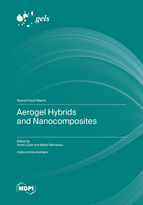Aerogel Hybrids and Nanocomposites
A special issue of Gels (ISSN 2310-2861). This special issue belongs to the section "Gel Chemistry and Physics".
Deadline for manuscript submissions: closed (31 July 2023) | Viewed by 24130
Special Issue Editors
Interests: aerogel synthesis; hybrid aerogels; catalytic and photocatalytic activity; fluorescent aerogels; analytical applications; supercritical adsorption; tissue engineering; bone substitution
Special Issues, Collections and Topics in MDPI journals
Interests: nanoparticles; aerogel synthesis; aerogel properties; materials synthesis; physicochemical characterization; crystallography; nanomaterials
Special Issues, Collections and Topics in MDPI journals
Special Issue Information
Dear Colleagues,
Aerogels are amazing lightweight solids, and the most beautiful ones have the rightly deserved name of solid smoke. They vary widely in their composition and can be of inorganic or organic origin. Due to their extremely low density, huge specific surface area, and open mesoporous structure, single-component aerogels have already claimed dozens of applications.
The Special Issue “Aerogel Hybrids and Nanocomposites” would like to focus on any aspect of the synthesis, production, structure, properties, and any applications of such complex aerogel materials while paying special attention to the cooperation between the hybrid matrix components and the guest particles.
Both original papers and reviews dealing with the synthesis, properties, and applications of inorganic, organic, or organic–inorganic aerogel hybrids or nanocomposites are welcome.
Dr. István Lázár
Dr. Melita Menelaou
Guest Editors
Manuscript Submission Information
Manuscripts should be submitted online at www.mdpi.com by registering and logging in to this website. Once you are registered, click here to go to the submission form. Manuscripts can be submitted until the deadline. All submissions that pass pre-check are peer-reviewed. Accepted papers will be published continuously in the journal (as soon as accepted) and will be listed together on the special issue website. Research articles, review articles as well as short communications are invited. For planned papers, a title and short abstract (about 100 words) can be sent to the Editorial Office for announcement on this website.
Submitted manuscripts should not have been published previously, nor be under consideration for publication elsewhere (except conference proceedings papers). All manuscripts are thoroughly refereed through a single-blind peer-review process. A guide for authors and other relevant information for submission of manuscripts is available on the Instructions for Authors page. Gels is an international peer-reviewed open access monthly journal published by MDPI.
Please visit the Instructions for Authors page before submitting a manuscript. The Article Processing Charge (APC) for publication in this open access journal is 2600 CHF (Swiss Francs). Submitted papers should be well formatted and use good English. Authors may use MDPI's English editing service prior to publication or during author revisions.
Keywords
- aerogel
- hybrid material
- nanocomposite
- matrix-guest interaction
- reinforcement
- adsorption
- supercritical extraction
- catalytic activity
- biomedical applications







